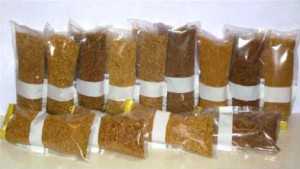Dried Distillers Grains with Solubles (DDGS), a co-product of the rapidly growing ethanol industry is an increasingly available ingredient that can be used cost effectively in hog diets. However, special attention needs to be given to the quality of the DDGS to be used in pig feeds as there is a large variation in quality between DDGS sources. Receiving low quality DDGS into a feed mill and including it in pig diets can have negative economic consequences on pig performance. Pig producers and pig feed manufacturers must ensure they are procuring consistently high quality corn DDGS at all times to capture the cost savings of using them. The following recommendations should be considered by swine feed manufacturers for the procurement of DDGS:
Know the source plant
The quality of DDGS can vary between and within manufacturing plants due to differences in manufacturing processes, process control, drying technology and ingredient quality control in the production of DDGS.
Quality standards need to be established and verified before price is a consideration. Use an approved-supplier process to select the plants that can provide DDGS that meet the required quality specifications. This includes obtaining nutrient specifications including proximate and amino acids analysis, mycotoxin analysis, and physical samples of the products.
The following specifications are recommended by Gowans Feed Consulting:
| Check list when buying corn DDGS. | ||
| Item | Minimum | Maximum |
| Crude protein, % | 27.0 | – |
| Fat, % | 9.0 | – |
| Phosphorus, % | 0.55 | – |
| Lysine | 2.80% of crude protein | – |
| ADF, % | – | 12.0 |
| NDF, % | – | 40.0 |
| Mycotoxins (ppm) in the finished feed | ||
| Aflatoxin | – | 0.02 |
| Vomitoxin | – | 1.00 |
| Fumonisin | – | 1.00 |
| Zearalone | – | 0.50 |
Specify the source plant and DDGS quality specifications in the purchase contracts
Incorporate the DDGS quality specifications including the analytical methods for nutrients and the name and location of the approved source plant into the purchase contract. Ensure that the supplier can trace the delivered DDGS back to the origin plant. This is especially important when the supplier is bringing multiple sources of DDGS in by rail and trans-loading onto trucks as there is a risk that DDGS from difference origins can be mixed up. Verify the supplier’s product liability insurance coverage.
Inspect the load and retain a sample
Obtain a representative sample of the DDGS before unloading and verify that it matches the original sample. Inspect the colour (a dark colour may indicate overheating and lower digestible lysine), check the odour (a burnt smell also may indicate overheating) and observe the bulk density and particle size. Reject the load if the representative sample does not closely match the original.
Samples of corn DDGS
Source: University of Minnesota http://www.ddgs.umn.edu
Monitor DDGS for mycotoxins and nutrient content
Mycotoxin content present in DDGS is three times the level that may be present in the corn used for the production of ethanol. Test the DDGS periodically for mycotoxin content to confirm that excessive levels are not present. Require routine nutrient information from DDGS suppliers.
For more information on feeding and buying DDGS visit the following organization’s websites:
U.S. Grains Council
University of Minnesota Distillers Grains By-products Web Site










